July 2017
Ostrava hosted prestigious WHO conference
Ostrava was the host city for the Sixth Ministerial Conference of the World Health Organization (WHO). This global event – which focused on Environment and Health – took place from 13–15 June at the multifunctional ‘Gong’ arena in Lower Vítkovice.
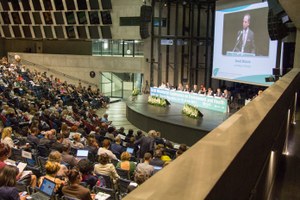 The conference was attended by around 500 delegates and observers from European countries, Canada, the Philippines and the United States, plus 15 international organizations and NGOs. During the three days of the conference program, participants assessed the progress made on environmental and health-related issues in the WHO’s European region and made a commitment to undertake a range of steps as set out in the concluding document of the conference – the Ostrava Declaration.
The conference was attended by around 500 delegates and observers from European countries, Canada, the Philippines and the United States, plus 15 international organizations and NGOs. During the three days of the conference program, participants assessed the progress made on environmental and health-related issues in the WHO’s European region and made a commitment to undertake a range of steps as set out in the concluding document of the conference – the Ostrava Declaration.
 Mayor Tomáš Macura outlined how this prestigious event benefited Ostrava: “We managed to set up many interesting contacts with other cities. The conference also represented an ideal opportunity to announce our candidacy for the title European Green Capital 2020 – and many institutions promised us their support for our bid.” Ostrava’s plans to become European Green Capital will include a range of steps to achieve further improvements in air quality throughout the region.
Mayor Tomáš Macura outlined how this prestigious event benefited Ostrava: “We managed to set up many interesting contacts with other cities. The conference also represented an ideal opportunity to announce our candidacy for the title European Green Capital 2020 – and many institutions promised us their support for our bid.” Ostrava’s plans to become European Green Capital will include a range of steps to achieve further improvements in air quality throughout the region.
This was only the second time that the WHO conference has been held in Central and Eastern Europe (after Budapest in 2004), and Ostrava is only the third non-capital city to host the event (following Frankfurt in 1989 and Parma in 2010). One of the main reasons for the WHO’s decision to choose Ostrava as a venue was the city’s unique history and its achievements in revitalizing former industrial sites.
During the WHO conference, Ostrava’s New City Hall hosted a parallel event featuring experts on environmental and health-related issues, and the City also organized a ‘Health Week’ for the general public – including health-themed open days, sporting activities, creative workshops and panel discussions focusing on air quality.
Conference documents and other information are available here.
Moravian-Silesian Innovation Centre to open in Ostrava
During this summer, the City of Ostrava (in conjunction with the Moravian-Silesian Region) is opening the Moravian-Silesian Innovation Centre (MSIC). The Centre will provide support and assistance to startup businesses and established companies. It will also help to attract growing businesses (including exporters) to the Region, as well as boosting investment in innovation and R&D and providing a platform for closer cooperation between industry and the academic sphere. The MSIC will be based at the Science and Technology Park (STP), next to the campus of the VŠB-Technical University of Ostrava.
Ostrava’s Mayor Tomáš Macura views the creation of the MSIC and the transformation of the Science and Technology Park as a step towards achieving one of the City’s strategic goals: “The City of Ostrava and the Moravian-Silesian Region both share the opinion that it is now necessary to expand the scope of the current Science and Technology Park to meet new challenges. The STP was established in 1997, and since then it has helped many companies to get started and make an impact on the market. Indeed, many companies have outgrown the capacity of the STP and moved to new premises. These include Tieto Czech – one of Ostrava’s most successful international IT companies, with around two thousand employees. But in recent years we began to feel that the STP was functioning more as a real estate agency rather than as an institution supporting innovations and startups. I am confident that the close cooperation between the City, the Region and our universities, combined with the valuable know-how gained from successful innovation centres elsewhere, will help us to achieve the required changes.”
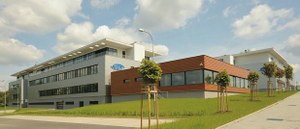 This year the City of Ostrava and the Moravian-Silesian Region signed a Memorandum of Cooperation in Supporting Business and Innovation. Both signatories declare their shared interest in coordinating the innovation environment in the Region – and their intentions are reflected in the increased funding provided to the Science and Technology Park and its transformation to create the Moravian-Silesian Innovation Centre. Regional President Ivo Vondrák explains the role of the Region’s universities in the project: “We are keen for the universities to be shareholders in the MSIC, because they are an important catalyst in the company’s operations.”
This year the City of Ostrava and the Moravian-Silesian Region signed a Memorandum of Cooperation in Supporting Business and Innovation. Both signatories declare their shared interest in coordinating the innovation environment in the Region – and their intentions are reflected in the increased funding provided to the Science and Technology Park and its transformation to create the Moravian-Silesian Innovation Centre. Regional President Ivo Vondrák explains the role of the Region’s universities in the project: “We are keen for the universities to be shareholders in the MSIC, because they are an important catalyst in the company’s operations.”
The MSIC’s registered capital was increased by 9.6 million CZK (5.9 million from the Region’s budget and the remaining 3.7 million from the City). The Region and the City will each have a 45% stake in the MSIC, with the remaining 10% held by three universities (the University of Ostrava, the VŠB-Technical University, and the Silesian University).
Ostrava gains upgraded rating
The international rating agency Moody’s has recently awarded Ostrava the highest rating in the City’s history – now increased from A2 positive to A1 stable. The upgrade comes just a year after Moody’s raised Ostrava’s rating from A2 stable to A2 positive.

Ostrava’s Mayor Tomáš Macura explained the importance of the rating: “We have reached the highest possible rating we can currently hold – we have the same rating as the Czech Republic, and no city can have a higher rating than the country in which it is located. This year we have moved up into the elite group – a step which recognizes our determination to manage the City’s finances with prudence, efficiency and transparency. A rating is not just something that is nice to have – the higher our rating, the better our access to external sources of funding, and the lower the cost of borrowing.”
Moody’s has issued credit ratings for Ostrava since 1998; during this period the City’s rating has gradually improved from Baa1 to the current A1. The only other Czech cities with an A1 rating are Prague, Brno and Prostějov. Ostrava’s rating is even better than that of the Moravian-Silesian Region (which is A2 stable).
A green light for startups
The Green Light programme – run by the VŠB-Technical University of Ostrava in conjunction with the City of Ostrava, the Moravian-Silesian Region and other partners – will help startup businesses to implement projects with high potential for market success.
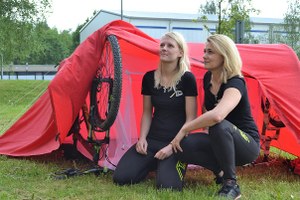 Launched four years ago, the Green Light programme is currently undergoing a number of changes. It is now shifting its focus to support startups, helping new businesses grow and develop.
Launched four years ago, the Green Light programme is currently undergoing a number of changes. It is now shifting its focus to support startups, helping new businesses grow and develop.
The Startup Accelerator – helping new businesses to develop their existing product and gain a foothold in the market – has already been up and running for four years. Entrepreneurs who have benefited from the accelerator include Radim Malinowski with his energy-saving EnLog lighting system, the TIKE team’s unique cycle tent, and the XTNB team whose electroboard has achieved success on markets all over the world – including the globally renowned Kickstarter forum.
The Green Light Start programme is targeted at entrepreneurs of all ages who have an innovative idea and are determined to transform it into a business reality. Andrea Šimoníková from the VŠB-Technical University of Ostrava’s Centre for Innovation Support – one of the partners in the programme – gave more details: “The Start programme is designed for complete beginners in business. We offer expert mentoring, helping to guide people along the path to transform their innovative ideas into reality – devising solutions or developing products and services. Our mentors share know-how and offer advice on key aspects of the process, preparing potential entrepreneurs to enter the real world of business. If successful, the startups can continue to develop their business in our Green Light Accelerator programme.”
For more information on how to get involved in the Start programme, visit the Green Light website at www.greenlight.vsb.cz. Registration was launched on 28 June 2017.
Ostrava’s City Assembly approves plan to donate city centre land to the University of Ostrava
The City of Ostrava has decided to donate around 3.3 hectares of land in the city centre to the University of Ostrava. The land will be the site of the University’s new Faculty of Fine Arts building and its Health and Fitness Centre.
The Ministry of Education, Youth and Sports has issued a call for projects as part of its Operational Programme Research and Education; the call is open to universities in three structurally disadvantaged regions of the Czech Republic. The University of Ostrava intends to apply for funding to build new premises for its Faculty of Fine Arts at the Black Meadow complex in Ostrava city centre and a Health and Fitness Centre near the Antonín Dvořák Theatre. The new buildings are scheduled for completion by 2020.
The City of Ostrava has decided to support these projects by donating around 3.3 hectares of land in the city centre to the University. The Miniuni tourist attraction, which currently occupies part of the land, will be relocated to the Silesian Ostrava Castle.
The City of Ostrava owns an additional 40 hectares of vacant land in the city centre, in ideal locations for commercial or office use, as well as for residential developments. More information on the available land can be found here.
City Council approves the result of the architectural competition for the conversion of the former municipal slaughterhouse "Jatka"
The City of Ostrava has recently held an international architectural competition in which ten architectural studios were invited to submit proposals for the conversion of the historic former municipal slaughterhouse complex to create premises for the PLATO Ostrava gallery. Eight proposals were received and evaluated by the competition jury, and the winning proposal was approved by Ostrava City Council on 2 May. The winner is the Prague-based Petr Hájek architectural studio.
Ostrava’s Mayor Tomáš Macura gave more details: “I consider it a great organizational achievement that we were able to choose the final winner just three months after announcing the competition. That’s around six weeks before the date we originally planned. I’m pleased that after a lively and expert debate, the jury reached an agreement on the proposals submitted, so we can now begin the next steps. Of course there is still plenty of work ahead of us, including discussions on the final version of the design and details of its implementation. We have announced three architectural competitions so far this year, and two winners have already been selected.”
 The jury praised the winning proposal as an impressive design which treated the original historic buildings with sensitivity. Out of all the submissions, the winning design best met the gallery’s requirements and the criteria set out in the competition – and it is fully in accord with Ostrava’s vision for its future development.
The jury praised the winning proposal as an impressive design which treated the original historic buildings with sensitivity. Out of all the submissions, the winning design best met the gallery’s requirements and the criteria set out in the competition – and it is fully in accord with Ostrava’s vision for its future development.
Marek Pokorný, the Director of the PLATO Ostrava gallery and the chairman of the competition jury, commented on the result: “Two years ago, when I suggested to the City that we should acquire the historic slaughterhouse and convert it for use as a contemporary art gallery, I never even dreamed that we would come so far in such a short time – the speed of the process is unprecedented in the Czech Republic. So for me personally, the result of the competition has brought great satisfaction. And of course it is excellent news for the gallery – an institution that has a very bright future ahead of it serving Ostrava and its cultural public. I am confident that citizens will support the winning proposal and feel pride in it.”
The second prize went to a proposal by the zerozero studio in Prešov (Slovakia), and third place was taken by architect Robert Konieczny’s KWK PROMES studio in Katowice (Poland). All the proposals are currently on public display in the former Bauhaus building near the slaughterhouse complex.
Popular competition supports innovation in the Moravian-Silesian Region
This year the Moravian-Silesian Region and its Regional Development Agency (RDA) are holding the 5th annual Regional ‘Innovative Company’ competition. The purpose of the competition is to motivate the Region’s companies to showcase their innovative ideas and business plans, while also raising the profile of the companies – and the Region as a whole – on the national and international stage.
This year’s competition is open to individuals, micro-businesses and SMEs from the Moravian-Silesian Region – and it also includes special categories for students from primary schools, secondary schools and universities.
For the company awards, the jury will evaluate innovation in products, technologies and services market-launched during the past three years. The Junior Innovator category is targeted specifically at entrants from primary schools.
For complete details of the competition rules (and application forms) see http://inovacnifirma-msk.cz
Winners of Ostrava’s Building of the Year 2016 awards announced
Ostrava’s Building of the Year competition – launched 23 years ago – has now announced the winners of the awards for 2016. A total of six buildings (completed between 1 January 2016 and 31 December 2016) were evaluated by members of the public via a web questionnaire.
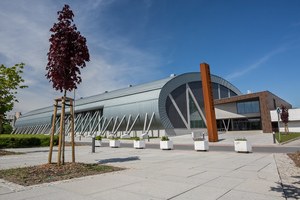 The competition jury assessed the overall impression and architectural quality of the buildings, as well as their layout, the area around the buildings, the interaction between the buildings and their environment, their technical quality, their positive contribution to life in the city, and whether they are examples worth following in the future.
The competition jury assessed the overall impression and architectural quality of the buildings, as well as their layout, the area around the buildings, the interaction between the buildings and their environment, their technical quality, their positive contribution to life in the city, and whether they are examples worth following in the future.
Based on the jury’s recommendations, the City Council judged the winner of the 2016 Building of Year competition to be the Vítkovice indoor athletics hall in the Zábřeh district, which came closest to meeting the required criteria and was awarded 300 000 CZK in prize money. A prize of 150 000 was awarded to the 4MEDi corporate biotech park for medical innovations in Ostrava-Poruba, and honorary awards (without prize money) went to the following buildings: the complete reconstruction of the apartment building at Přívozská 1628/36 in the city centre (including a new elevator); the ROPER Engineering factory and office building at Výstavní 3374/40a in Moravská Ostrava; and the ‘Antracit House’ building at Lihovarská 689/40A in Ostrava-Kunčičky.
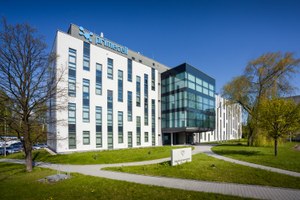 The competition also included a public vote, held via a web questionnaire. Almost 800 members of the public participated in this vote, and the winner of the public award was the 4MEDi corporate biotech park for medical innovations (385 votes), followed by the Vítkovice athletics hall (242 votes) and the ‘Antracit House’ building (58 votes).
The competition also included a public vote, held via a web questionnaire. Almost 800 members of the public participated in this vote, and the winner of the public award was the 4MEDi corporate biotech park for medical innovations (385 votes), followed by the Vítkovice athletics hall (242 votes) and the ‘Antracit House’ building (58 votes).
A window into history:
On 4 June 1996, the Italian company Video On Line linked its infrastructure in Central and North Moravia up to the global internet network.
The Ostrava–Prague and Olomouc–Prague connections had a data capacity of 64 kb per second, and users could purchase time-unlimited internet access for a fixed fee of 495 CZK per month. The Czech internet was still in its infancy. Ondřej Neff’s internet newspaper Neviditelný pes (‘The Invisible Dog’) was launched on 23 April, and on 30 April Ivo Lukačovič announced the launch of his web directory Seznam. Several print newspapers were beginning to set up online versions. By the end of the year, the number of internet users in the Czech Republic had risen to 30 thousand.
Compiled by the Ostrava City Archives



